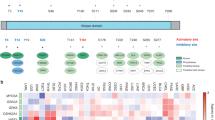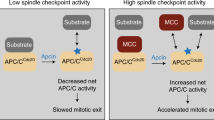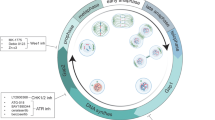Abstract
We have studied the role of cyclins and cyclin-dependent kinase (CDK) activity in apoptosis induced by camptothecin (CPT). In this model, 22% of the cells stain for annexin-V at 24 h and then proceed to be 93% positive by 72 h. This time window permits the analysis of cyclins in cells that are committed to apoptosis but not yet dead. We provide evidence that cyclin protein levels and then associated kinase levels increase after CPT treatment. Strikingly, cyclin B1 and cyclin E1 proteins are present at the same time in CPT treated HT29 cells. Although cyclin B1 and E1 CDK complexes are activated in CPT treated cells, only the cyclin B1 complex is required for apoptosis since reduction of cyclin B1 by RNAi or roscovitine treatment reduces the number of annexin-V-stained cells. We have detected poorly organized chromosomes and phosphorylated histone H3 epitopes at the time of maximum cyclin B1/CDK kinase activity in CPT-treated cells, which suggests that these cells enter a mitotic catastrophe. Understanding which CDKs are required for apoptosis may allow us to better adapt CDK inhibitors for use as anti-cancer compounds.
This is a preview of subscription content, access via your institution
Access options
Subscribe to this journal
Receive 50 print issues and online access
$259.00 per year
only $5.18 per issue
Buy this article
- Purchase on Springer Link
- Instant access to full article PDF
Prices may be subject to local taxes which are calculated during checkout









Similar content being viewed by others
Abbreviations
- CDK:
-
cyclin-dependent kinase
- CPT:
-
camptothecin
- FCS:
-
fetal calf serum
- PI:
-
propidium iodide
References
Abal M, Bras-Goncalves R, Judde JG, Fsihi H, De Cremoux P, Louvard D et al. (2004). Oncogene 23: 1737–1744.
Adachi S, Obaya AJ, Han Z, Ramos-Desimone N, Wyche JH, Sedivy JM . (2001). Mol Cell Biol 21: 4929–4937.
Bartek J, Lukas J . (2001). FEBS Lett 490: 117–122.
Borgne A, Golsteyn RM . (2003). Progress in Cell Cycle Research, Vol 5 In: Meijer L, Jézéquel A and Roberge M (eds). Life in Progress Editions: Roscoff, France, pp 453–459.
Castedo M, Perfettini J-L, Roumier T, Kroemer G . (2002a). Cell Death Diff 9: 1287–1293.
Castedo M, Roumier T, Blanco J, Ferri KF, Barretina J, Tintignac LA et al. (2002b). EMBO J 15: 4070–4080.
Choi KS, Eom YW, Kang Y, Ha MJ, Rhee H, Yoon J-W et al. (1999). J Biol Chem 274: 31775–31783.
Coqueret O . (2003). Trends Cell Biol 13: 65–70.
De Luca A, De Maria R, Baldi A, Trotta R, Facchiano F, Giordano A et al. (1997). J Cell Biochem 64: 579–585.
Elbashir SM, Harborth J, Weber K, Tuschl T . (2002). Methods 26: 199–213.
Fotedar R, Flatt J, Gupta S, Margolis RL, Fitzgerald P, Messier H et al. (1995). Mole Cell Biol 15: 932–942.
Furuta T, Takemura H, Liao ZY, Aune GJ, Redon C, Sedelnikova OA et al. (2003). J Biol Chem 278: 20303–20312.
Golsteyn RM . (2005). Cancer Lett 217: 129–138.
Guo M, Hay BA . (1999). Curr Opin Cell Biol 11: 745–752.
Hakem A, Sasaki T, Kozieradzki I, Penninger JM . (1999). J Exp Med 189: 957–967.
Hartwell LH, Kastan MB . (1994). Science 266: 1821–1828.
Harvey KJ, Blomquist JF, Ucker DS . (1998). Mole Cell Biol 18: 2912–2922.
Harvey KJ, Lukovic D, Ucker DS . (2000). J Cell Biol 148: 59–72.
Hiromura K, Pippin JW, Fero ML, Roberts JM, Shankland SJ . (1999). J Clin Invest 103: 597–604.
Hsu S, Yin S, Liu M, Reichert U, Ho WL . (1999). Exp Cell Res 252: 332–341.
Hyzy M, Bozko P, Konopa J, Skladanowski A . (2005). Biochem Pharmacol 69: 801–809.
Knockaert M, Greengard P, Meijer L . (2002). Trends Pharmacol Sci 9: 417–425.
Konishi Y, Lehtinen M, Donovan N, Bonni A . (2002). Mol Cell 9: 1005–1016.
Léonce S, Perez V, Lambel S, Peyroulan D, Tillequin F, Michel S et al. (2001). Mol Pharmacol 60: 1383–1391.
Li K, Lin SY, Brunicardi FC, Seu P . (2003). Cancer Res 63: 3593–3597.
Livak KJ, Schmittgen TD . (2001). Methods 25: 402–408.
MacCallum DE, Melville J, Frame S, Watt K, Anderson S, Gianella-Borradori A et al. (2005). Cancer Res 65: 5399–5407.
Maity A, Hwang A, Janss A, Phillips P, McKenna WG, Muschel RJ . (1996). Oncogene 13: 1647–1657.
Mazumder S, Gong B, Almasan A . (2000). Oncogene 19: 2828–2835.
Mazumder S, Gong B, Chen Q, Drazba JA, Buchsman JC, Almasan A . (2002). Mol Cell Biol 22: 2398–2409.
Meijer L, Arion D, Golsteyn R, Pines J, Brizuela L, Hunt T et al. (1989). EMBO J 8: 2275–2282.
Meijer L, Borgne A, Mulner O, Chong JP, Blow JJ, Inagaki N et al. (1997). Eur J Biochem 243: 527–536.
Meikrantz W, Gisselbrecht S, Tam SW, Schlegel R . (1994). Proc Natl Acad Sci 91: 3754–3758.
Meikrantz W, Schlegel R . (1996). J Biol Chem 271: 10205–10209.
Padmanabhan J, Park DS, Greene LA, Shelanski ML . (1999). J Neurosci 19: 8747–8756.
Park DS, Farinelli SE, Greene LA . (1996). J Biol Chem 271: 8161–8169.
Pines J, Hunter T . (1989). Cell 58: 833–846.
Porter DC, Zhang N, Danes C, McGahren MJ, Harwell RM, Faruki S et al. (2001). Mol Cell Biol 21: 6254–6269.
Porter LA, Cukier IH, Lee JM . (2003). Blood 101: 1928–1933.
Porter LA, Singh G, Lee JM . (2000). Blood 95: 2645–2650.
Price PM, Safirstein RL, Megyesi J . (2004). Am J Physiol Renal Physiol 286: 378–384.
Sauve DM, Anderson HJ, Ray JM, James WM, Roberge M . (1999). J Cell Biol 145: 225–235.
Scatena CD, Stewart ZA, Mays D, Tang LJ, Keefer CJ, Leach SD et al. (1998). J Biol Chem 273: 30777–30794.
Shao RG, Cao CX, Shimizu T, O’Connor PM, Kohn KW, Pommier Y . (1997). Cancer Res 57: 4029–4035.
Shen M, Feng Y, Gao C, Tao D, Gong J . (2002). Chin J Oncol 24: 215–218.
Shen M, Feng Y, Gao C, Tao D, Hu J, Reed E et al. (2004). Cancer Res 64: 1607–1610.
Shi L, Chen G, He D, Bosc DG, Litchfield DW, Greenberg AH . (1996). J Immunol 157: 2381–2385.
Shi L, Niskioka WK, Th’ng J, Bradbury EM, Litchfield DW, Greenberg AH . (1994). Nature 263: 1143–1145.
Shimizu T, O’Connor PM, Kohn K, Pommier Y . (1995). Cancer Res 55: 228–231.
Shirvan A, Ziv I, Zilkha-Falb R, Machlyn T, Barzilai A, Melamed E . (1998). Neurochem Res 23: 767–777.
Smits VA, Klompmaker R, Arnaud L, Rijksen G, Nigg EA, Medema RH . (2000). Nat Cell Biol 2: 672–676.
Stead E, White J, Faast R, Conn S, Goldstone S, Rathjen J et al. (2002). Oncogene 21: 8320–8333.
Tanizawa A, Fujimori A, Fujimori Y, Pommier Y . (1994). J Natl Cancer Inst 86: 836–842.
Vesely J, Havlicek L, Strnad M, Blow JJ, Donella-Deana A, Pinna L et al. (1994). Eur J Biochem 224: 771–786.
Wang J, Walsh K . (1996). Science 273: 359–361.
Yuan J, Yan R, Kramer A, Eckerdt F, Roller M, Kaufmann M et al. (2004). Oncogene 23: 5843–5852.
Acknowledgements
This work was supported by the Institut de Recherches Servier as part of a program ‘Alliance Stratégique’ with the CNRS. We thank our colleagues in the Cancer Drug Discovery division at the IdRS for valuable discussions and Marie Knockaert for pg beads and advice.
Author information
Authors and Affiliations
Corresponding author
Rights and permissions
About this article
Cite this article
Borgne, A., Versteege, I., Mahé, M. et al. Analysis of cyclin B1 and CDK activity during apoptosis induced by camptothecin treatment. Oncogene 25, 7361–7372 (2006). https://doi.org/10.1038/sj.onc.1209718
Received:
Revised:
Accepted:
Published:
Issue Date:
DOI: https://doi.org/10.1038/sj.onc.1209718
Keywords
This article is cited by
-
Modulation of cell cycle increases CRISPR-mediated homology-directed DNA repair
Cell & Bioscience (2023)
-
Human embryonic stem cells display a pronounced sensitivity to the cyclin dependent kinase inhibitor Roscovitine
BMC Molecular and Cell Biology (2019)
-
Antiapoptotic effects of roscovitine on camptothecin-induced DNA damage in neuroblastoma cells
Apoptosis (2011)
-
Involvement of cyclin B1 in progesterone-mediated cell growth inhibition, G2/M cell cycle arrest, and apoptosis in human endometrial cell
Reproductive Biology and Endocrinology (2009)
-
New alternative phosphorylation sites on the cyclin dependent kinase 1/cyclin a complex in p53-deficient human cells treated with etoposide: possible association with etoposide-induced apoptosis
Apoptosis (2007)



